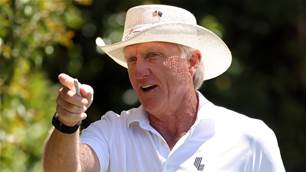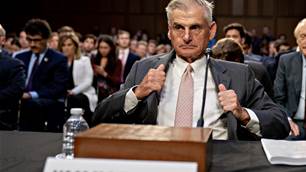This nonsense has gone on way too long.
The game of golf that I once loved is withering on a vine of obscene greed and I’ve had a gutful.
This is NOT about LIV, although it has been – and will continue to be – a clear catalyst for change.
This is about the American PGA Tour, the real reason we’re in this insidious predicament as a sport.
Don’t get me wrong, 95 percent of my pro golf memories have come from televised events on the US PGA Tour.
Actually, when I think about it, that might be about 50 percent – I’ve learnt way more in a shorter space of time watching live tournaments.
No, that’s not right either. I can scarcely recall any event from the United States that isn’t a team event or a major championship, so maybe it’s 25 percent.
No, no. Now that I think more clearly, most of the tracks I can walk you around are actually British links courses because they’re far more memorable and we get to see so few of the great American courses.
So, it’s perhaps 10 percent – and about nine of those would involve Australians winning (or nearly winning).
So, thanks for almost nothing US PGA Tour.
You’ve taken our superstars away from home, demanding they play imposingly long schedules that mean they have no chance of a combination of “down time” AND to play meaningfully at home.
For those on the next tier, your shamefully insular wraparound schedule has meant for a generation that they’re effectively bound to play in the Fall Series events that have been the death knell of several national championships of historic note.
You’ve come to Australia – and other golf-loving countries that don’t have gajillionaires to bankroll your money-hungry ways – approximately no times outside the Presidents Cup in generations.

And speaking of the Presidents Cup, if you don’t live in North America or Melbourne, you’d need to have been in Korea in 2015 or South Africa in 2003 to have laid eyes on the “rest of the world” team in action. And that doesn’t change until at least 2032 for an event that began in 1994.
Now don’t get me wrong, I want to scream at the social aspects of LIV, too – I’m far from a fan of Saudi politics and human rights.
But I’ll leave that stage to others better versed.
I have, however, had experience with those based in Jacksonville – and for them to be screaming bloody murder about a highly predictable fox in their once impenetrable hen house would be almost laughable if it weren’t so impactful on golf.
My due respect to fellow Golf Australia magazine columnist Geoff Ogilvy. I take his point in a recent issue of this publication about the almost “accidental” nature of the PGA Tour’s role as something of a “bully” of international golf.
But, sorry Geoff, I’m sick of accidents.
For the good of the sport – and the sanity of those in this nation who follow it – we can’t afford them any longer.
I’m not talking about it from a players’ perspective and wish nothing but prosperity for the Aussie boys skilful enough to have reached the upper echelon. Even to those handful who’ve taken up the LIV offer, I don’t bear any grudge, whatsoever
But let’s start at the top.
I had the rare opportunity to speak with PGA Tour boss Jay Monahan at the 2019 Presidents Cup and jotted down a few of his thoughts. Lovely man, slick speaker, wasn’t remotely fazed by me asking questions about us “down under” feeling left out.
Gave me the American golf hierarchy’s well-worn volley of platitudes about how amazing the Sandbelt was, how knowledgeable Australian crowds were, how much the players enjoyed being here – and so on. You’ve heard it 100 times.
He described Australia as a passionate “market” where the Tour would like to have a foothold, but that essentially the more “mature markets” of China, Japan and Korea held the limited number of “international” cards it would be able to play in the medium term.
Sure, I get the regional grouping and associated travel benefits of an “Asian swing”. But don’t give us the bollocks about “maturity”. (Not to mention the links with China at all given the tour’s current political stance.)

We have been a pipeline of world-class players to the US of A for way more than half a century; our courses are routinely among the global rankers’ best; and the way our big tournaments are run always draws praise.
And we’re not a f***ing “market”, we’re a country.
Golf to the US PGA Tour is, was and always will be about money, pure and simple.
No government can sustainably continue to pour in the millions of dollars like corporate giants such as Zozo. So, unless BHP, Rio Tinto or one of our big banks take golf to their hearts, we’re out.
So, I wonder who else has got money to help?
Oh, that’s right … the PGA Tour!
The same tour that has mystically discovered cash reserves to pay for the obscene Player Impact Program. And now on (or at least nearing) the other side of Covid and LIV’s raid, the cash to suddenly support a raft of megabuck no-cut events for its elite.
Or maybe ponder the following questions, like so many of you have no doubt done in recent years.
What happened to the W in WGC?
Why aren’t pace of play rules enforced on tour, particularly when it undoubtedly is the shop window of golf to the world and slow play is golf’s own pandemic?
LIV aside, why does the PGA seemingly have a seat at every impactful committee in world golf, yet no meaningful change has emerged in years?
Why are U.S collegiate golfers seemingly given the inside running to cards?
Why are there now more layers for international players to conquer to even reach the supposedly “global tour” than ever before?
Why does the PGA Tour schedule so many events throughout the year these days, when their events hurt our fields?
So many questions, so few answers that will appease curious minds in antipodean lands.
A cynical person might say the PGA Tour is the ultimate “boys’ club” where those closest to the wallets when the music stops just help themselves to a little more.
Let’s not forget, despite the always slick appearance to the contrary, the PGA Tour is, by definition, a glorified players’ union.
It is run for the players by a group of extremely well-paid executives – some of, if not THE best in the sports world – who ensure their pay cheques and futures by making those same players insanely rich.
It’s very cosy. If one group makes money, the others make more again. And yes, it really has been that simple.
Until LIV, that is.
So, as we all start to ponder what the landscape of golf will become, sure, let’s keep the pressure on the Saudis and ensure as best we can that a spotlight is maintained on the world’s human rights expectations.
And not that I’m comparing their deeds, but as golf fans, let’s also ensure the PGA Tour answers a few of these questions satisfactorily.
And as you write off this angst-riddled article, ponder one last factor at play here.
The chances of our key domestic events this summer becoming global attractions that lure media coverage and legitimate fields probably hang in the balance right now with Cam Smith and Marc Leishman having signed (among others) to play, particularly in the ground-breaking Australian Open that aligns with the female championship for the first time.
It will be absolutely fascinating to see how our very own PGA of Australia react to the requests (or demands) of their American counterparts.
Theoretically, LIV gives a few of our players the best chance in years to come and shine in their national championship.
But will our U.S cousins impose their desire to ban the “rebels” on arguably the most junior fellow member of the laughably named International Federation of Tours?

Perhaps more interestingly, with LIV sniffing around Australian clubs for a venue to host one or more events in our neck of the woods, will the PGA of Australia defer to big brother, or will they be true to their charter of giving more local pros as many playing opportunities as possible and giving the sport the highest profile it can muster, regardless of how many Aussies actually make the field?
Remember, the vast majority of our great Aussie golfers rely on their PGA of Australia to give them their “shot” at a professional career.
When the U.S PGA Tour has been reduced to pandering to the elite yet still wishes to impose its will on its poorer siblings around the world, those paths are logically on a collision course.
Mike Clayton has long been an advocate of a true global tour – maybe this represents our best chance to push back and advance that concept.
It would be much easier to fall in behind the US PGA Tour’s thoughts if they occasionally turned a sympathetic ear to our previously unheard cries.
Related Articles

Huggan: LIV update… or downdate

'Frustrated' board member quits due to PGA-LIV stall













